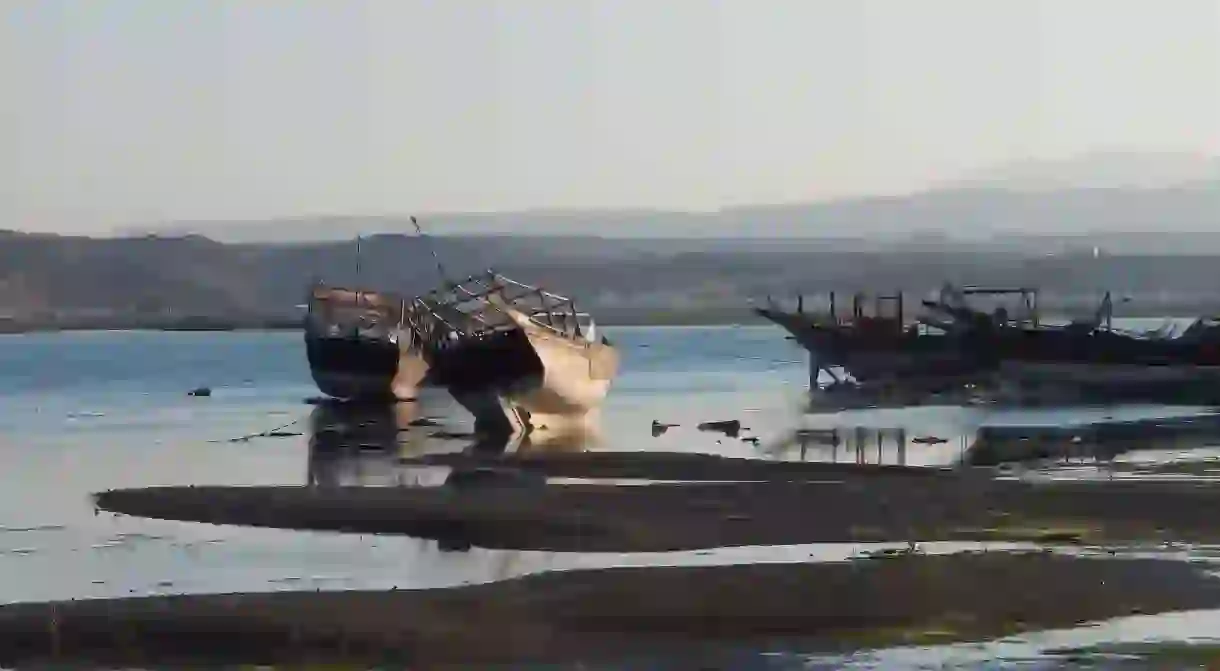Here's Why Oman Is the Perfect Place to Go off the Grid

Thanks to the mosaic of mountains, deserts, and biodiverse areas that make up Oman, there’s simply no better place to unwind, disconnect and chart your own path. If you’re searching for a break from the Middle East’s megacities, check out our list of the best places to visit in Oman next time you’re looking to go off the grid for a little R&R.
Escape city life in Jebel Akhdar
Located in the Sultanate’s highly mountainous interior, Jebel Akhdar has grown into one of Oman’s most popular mountain retreats over the past few years. Its name, which means ‘green mountain’ in Arabic, comes from the lush green trees and vegetation found in the valleys near its summit. Those same valleys are home to numerous hiking trails and old villages, where Omani tribes have lived for centuries.
Its stunning scenery has become the stuff of legend, with plateaus and mountainside villages full of wildlife, greenery, and streams of water. Always multiple degrees cooler than nearly every other part of northern Oman, its long list of visitors includes Princess Diana, who popularised one the Jebel’s most extraordinary viewpoints.
Hikers will find the winding trails of the mountain exhilarating for the rose farms, old homes, and mosques that line their path.
With two highly luxurious hotels, Jebel Akhdar is a perfect getaway for those who want to be close to nature and escape north Oman’s seasonal heatwaves, without completely giving up the comforts of modern life.
Camp in the Wahiba Sands and discover Bedouin life
Lying 200 km (124 miles) south of the capital Muscat, Wahiba Sands are home to numerous desert camps where travellers can live like Bedouin and be at one with the sands. The smooth and majestic dunes of Wahiba, with its wandering camels and near endless opportunities for adventure, are home to a strong traditions of Arab hospitality that many have heard about but never experienced.
The red hues of the desert have been home to nomadic tribes for centuries, its horizon still dominated by thousands of mountainous dunes and their jagged peaks. Here, every guest is treated like a king, with cups of roasted coffee forming the centerpiece of a culture born in the desert and shaped by time.
With camel farms, souks, and historic forts all within close proximity to the desert, this spot is one of the best places in the Sultanate to disconnect and become immersed in an entirely different way of life.

Explore massive wadis and calming beaches from Tiwi
Equal parts serene and mesmerising anytime of day, the coastal village of Tiwi is the ideal spot for a short camping trip from Muscat, being less than 100 km (62 miles) south of Oman’s capital.
Adding to Tiwi’s popularity is its close proximity to many of Oman’s most famous natural gems, including Wadi Shab, Hawiyat Najm, and the Wadi Dhayqah Sam.
Besides short excursions and nights along the Arabian Sea, Tiwi is also a great place to head out to sea with local villagers and get a taste of Oman’s rich maritime traditions.
Take off from Sur in a wooden dhow
For hundreds of years, merchant ships from the city of Sur traded extensively with ports throughout Asia and East Africa, bringing back riches from Zanzibar, Persia, India, and Basra. Suri ships have earned a place in the proud maritime history of Oman, and while they no longer ply the high seas, visitors can have their own coastal adventure by booking a wooden dhow. After taking in Sur’s mesmerisng views, head to the local shipbuilding yard to learn how these majestic vessels are made.

Choose between mountains and the sea while in Dhofar
Whether looking for mist-covered and evergreen mountains or miles of pristine coastline, Dhofar has got you covered. Throughout the monsoon season, which lasts from July to September, Oman’s southernmost region is transformed by the near constant rainfall and cool breezes brought by the Indian Ocean.
Over the years, Dhofar’s capital Salalah has become a byword for rest and relaxation, with hundreds of thousands of visitors annually looking to escape region’s sweltering summer heat in Salalah’s rejuvenating climate. Year after year, the region welcomes them to its numerous springs, souks, and mountain trails with open arms.
Be at one with nature in the Dimaniyat Islands
Located around 20 minutes from the coast of Muscat, the Dimaniyat Islands comprise a nature reserve widely regarded as one of Oman’s most popular natural wonders. Wildlife of all kinds thrive in aquamarine waters and sandy shores of Dimaniyat, with the patient traveller occasionally rewarded with the site of migrating dolphins and whales passing through the Arabian Sea.
What makes Dimaniyat unique are the sea turtles, coral reefs, marine life, and migratory birds that can be seen there. From ospreys and spinner dolphins to the hundreds of hawksbill and green turtles that nest there annually, Dimaniyat is a unique haven for wildlife that has quickly gained traction as a major eco-tourist destination. With over 22 dive sites located within the reserve, it has also become great for divers looking to take the plunge and discover Oman beneath the waves.
Head north to Musandam
The Musandam Peninsula is one of Oman’s most biodiverse regions, with dozens of islands off its coast just waiting to be explored. Its turbulent history has also given birth to a unique mixture of cultures that include the Kumzar and Shehi ethnic groups, which each speak their own language.
The old villages, forts, and fjords that dot the peninsula rarely see crowds, making it a serene getaway far from the tourist traps common in the region. There is something for everyone in the Sultanate’s northernmost governorate, with places like Kumzar, the historic Khasab Castle, and its coastal islands waiting to be explored. Even the more luxury-inclined traveller has plenty to keep them occupied, with a number of world-class hotels ready to cater to their every need.













